Peony (Paeonia) belongs to the monotypic genus of perennial herbaceous plants. This genus is the only one in the peony family. There are about 40 types of such plants. Among them there are herbaceous, treelike, and also species that combine the characteristics of both treelike and herbaceous. Under natural conditions, such plants can be found in the subtropical and temperate regions of Eurasia, as well as North America. For the first time, peonies began to be cultivated more than 2 thousand years ago, and this happened in China during the Han era. This plant got its name in honor of the famous healer, whose name was Pean. He could heal both a common man and a god from any mortally dangerous wounds that appeared as a result of fierce battles. Herbaceous peonies are the most popular among gardeners of middle latitudes. They have large, incredibly beautiful and fragrant flowers. They bloom in the last month of spring and decorate the bushes for about 6 weeks. It is about them that will be discussed below.
Content
Peonies features
Peonies are semi-shrub (tree-like), shrub, and also herbaceous. The height of the bushes can reach 100 centimeters. On a fairly large rhizome, powerful cone-shaped roots are located. There are several shoots. Alternately located unpaired pinnately separated or trifoliate leaves are painted in all color shades of gray, green, and also dark purple. Single flowers are very large (about 15–20 centimeters in diameter), they look great both on a bush and in a cut. Such a plant has a non-capricious character and is very easy to care for. Thanks to their spectacular foliage, even after flowering is over, peonies will delight with their beauty even until autumn. Such plants grow and develop well in the same place for several decades. To date, thanks to breeders, more than 5 thousand different varieties have been born.For the most part, they were bred by crossing the medicinal peony and the milk-flowered peony. The difference between the varieties lies in the color and size of the flowers, in the duration of flowering, as well as in the height and outline of the bush.
Planting a peony in open ground
How to plant peonies
Growing such plants is not a troublesome task that will take you a lot of time. It is worth paying special attention to the choice of a site suitable for planting, since peonies will grow on it for quite some time. In an adult bush, the roots go deep (about 70–90 centimeters) into the ground, and in this regard, after the peony reaches the age of 4 or 5 years, it will be rather difficult to transplant it to a new place. You should choose an illuminated area, and these plants need direct sunlight for 5-6 hours, and always before lunch. Plants react extremely negatively to a draft, therefore it is recommended to plant them under tall bushes or trees. It is not recommended to choose lowlands for planting, since rot can form on the root system due to stagnation of liquid in the soil.
Peonies grow well on loam, the acidity of which is 6-6.6 pH. If the soil is too clayey, then it can be corrected by adding sand, peat and humus. Clay, peat, and humus must be added to the sandy soil. Wood ash, sand, and organic matter should be added to the peat soil.
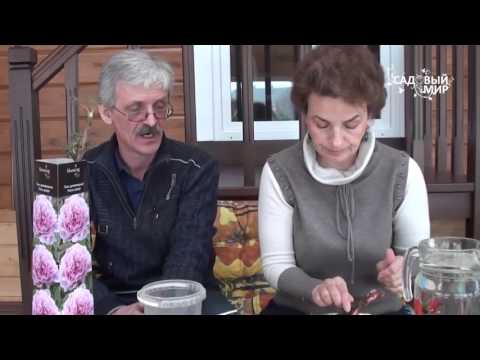

Watch this video on YouTube
Planting peonies in autumn
Planting and transplanting of such flowers is carried out in the last August and first September days. The hole should be prepared 7 days before planting, while it should measure 60x60x60. The distance between the pits should not be less than 70-100 centimeters. At the bottom you need to make a good drainage layer, the height of which should be equal to 20-25 centimeters. It is made from broken brick or crushed stone, as well as coarse sand. After that, a nutrient mixture is poured, which includes humus, 200 grams of superphosphate, 300 grams of wood ash, compost, 100 grams of lime, 100 grams of potassium sulfate, while the layer should be 20 to 30 centimeters high. Therefore, soil mixed with compost is poured into the hole. Before planting, the soil will settle, and you can place the plant's rhizome in the hole. Then it is covered with garden soil and tamped a little. It should be remembered that it is impossible to deepen the peony during planting, because in this case it will have dense foliage, but it will not bloom. If you want your plants to be strewn with flowers, in this case you need to deepen the rhizome so that the upper bud is at a depth of 3 to 4 centimeters, no more. Also, do not forget that the transplanted plant does not form flowers in the first year and has a sluggish appearance. It may happen that flowering also does not occur in the next year. Do not be afraid if the bush does not externally show signs of disease. The problem may be that the peony is simply not ripe.
Planting peonies in spring
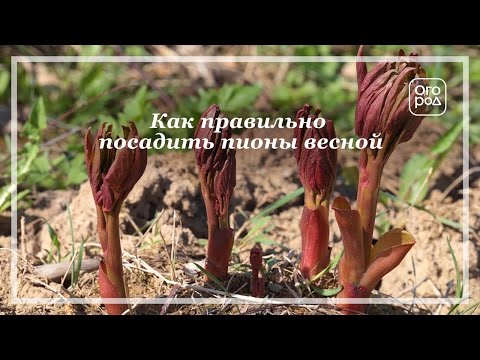

Watch this video on YouTube
As a rule, such plants are not planted in spring. If it is in the spring that you have excellent planting material, then its experts advise saving it without planting it in open soil. To do this, it is planted in a pot with a volume of 2 to 3 liters and transferred to a dark, cool place (cellar, basement). In this case, the substrate in the pot should be slightly moistened all the time. Experienced flower growers advise for this to spread pieces of ice or snow on the surface of the substrate, in the process of melting it will cool and moisten the soil. In the last days of April or in May, the peony must be transferred to the garden and placed in the dug hole right with the pot. Then everything is buried. In autumn, it is transplanted together with a lump of earth (by means of transshipment) to a permanent place.
Outdoor peony care
Peony care in autumn
In autumn, it is time to plant and transplant such a plant. In the case when transplanting and planting is not carried out, you just need to cut off the withered leaves and shoots. It is recommended to burn the trimmed parts of the plant, as they may contain viruses, pests and bacteria. It is recommended to sprinkle what remains of the shoots with wood ash, while 2 or 3 handfuls are taken for 1 bush.
Peony care in spring
You don't need to water the peonies too often. One adult bush takes 20–30 liters of water, as it must penetrate to the depth at which the root system lies. Especially such plants need watering in early spring, during intensive growth, as well as during the formation of buds and flowering, and even in August-September, since it is at this time that young buds are laid. When the plant is watered, it is necessary to loosen the surface of the soil and, in the presence of weeds, be sure to remove it. Watering should be done at the root so that the liquid does not end up on the surface of the leaf plates.
How to feed
After the snow cover has completely melted, the soil near the bushes should be shed with a disinfectant solution. To prepare it, pour from 2 to 3 grams of potassium permanganate into a bucket of water, this volume of solution is enough for watering 2 bushes. At the beginning of the period of intensive growth, peonies are fed with a solution of ammonium nitrate (15 grams of substance per bucket of water). From May 8, flowers need to be watered with foliage from a watering can with a strainer with a solution of complete mineral fertilizer, in the dosage indicated on the package. Such feeding is carried out once every 30 days. It is recommended to add regular washing powder to the nutrient solution (1 tbsp per bucket of water). In this case, the solution will linger on the leaves, and not just drain into the soil. Peonies should be fed in this way in the evening or on a cloudy day. When the buds form and during flowering, you need to feed the plants with a solution consisting of 7.5 grams of ammonium nitrate, 10 grams of superphosphate, 5 grams of potassium salt and a bucket of water. Half a month after the peony has faded, fertilizer is applied to the soil, consisting of a bucket of water, 5 grams of potassium salt and 10 grams of superphosphate. Alternative fertilization with mineral and organic fertilizers is possible. Moreover, they can be poured dry into a previously prepared groove that runs around the bush. Then the fertilizer is moistened and embedded in the soil.
In the summer, when the flowering ends, the plant will only need to be watered in a timely manner, do not forget to apply fertilizers after flowering, loosen the soil in time and remove weeds.


Watch this video on YouTube
Pruning
It is necessary to completely cut the stems in the autumn, when the first frosts come. If you need to do this before the specified time, then after you cut off the shoots, their remains should rise above the soil surface, on which 3-4 leaf plates must remain. And all because at the end of the summer period, replacement buds are laid in such plants, and in order for this to end successfully, there must be several leaves on the bush. When cutting flowers, it must be remembered that it is imperative to leave a part of the shoot with several leaves.
Peony transplant
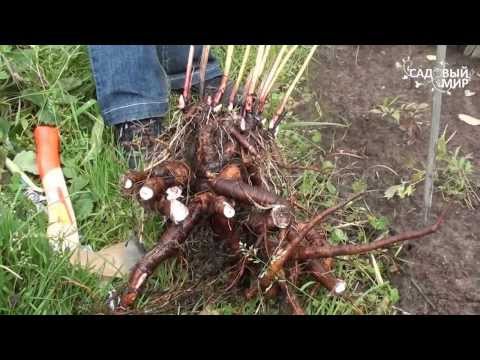

Watch this video on YouTube
When to transplant peonies
In the wild, these plants are capable of growing in one place for more than 50 years. Those hybrid varieties that were created using the medicinal peony can be grown in the same place for no longer than 10 years. Then the bush must be dug up, divided and planted in a new place. And in this way you can quickly and easily propagate peonies. But it is worth remembering that only those bushes that are at least 4 or 5 years old are suitable for reproduction, while they should fully bloom 1-2 times. Remember that the older the plant, the more powerful and overgrown its rhizome.Therefore, in order to simplify the transplanting process for yourself and prevent a decrease in the quality of flowering, transplant and at the same time separate the bushes, experienced gardeners advise 1 time in 3 or 4 years. The transplant should be carried out in the first autumn month.
Autumn transplant
In autumn, you should carefully dig in the bush, while stepping back from the rhizome by 25 centimeters. After that, it is carefully loosened with a pitchfork and pulled out of the ground. Remove any remaining soil from the root system using a peg and then wash it. The stream of water should not be very strong, as this can lead to injury to the delicate kidney-eyes. The green part should be cut almost to the root. The root should be placed in the open air and left for a while. During this time, water should drain from it, and the rhizome will become wilted and acquire more elasticity. Old, thick enough roots need to be trimmed, leaving 10 to 15 centimeters. The cut must be done at an angle of 45 degrees. Conduct a thorough examination of the rhizome and only then start dividing it. It is recommended to stick a wedge into the middle of the old bush, driving it in with a hammer. As a result, the root system itself will split into several parts. Often there are voids in the middle of the rhizomes of old bushes, as well as rotting areas. They should be thoroughly cleaned and disinfected with a strong solution of potassium manganese. After this, the cut sites should be treated with a fungicide. Each of the divisions should have a part of the bark neck with developed 3 or 4 eyes, and the presence of several roots is also necessary. Try to make the divisions approximately equal in size. So, too large cuttings can hurt for a long time, and small ones quickly die.
How to transplant peonies
Delenki are planted in the same way as the plants themselves. And this landing method is described above. On the surface of the ground where the peonies were planted, a layer of mulch should be poured, which should be about 7 centimeters, peat is perfect for this purpose. It will be necessary to remove the layer of mulch only after the sprouts of peonies, which have a red color, break through it in spring. The transplanted flowers will form the root system within 2 years, and in order for this process to be successful, it must not be allowed to bloom. During the first year after planting, absolutely all the buds must be removed. And in the second year, only 1 bud should be left. When it bursts, you should cut it as short as possible. This is necessary in order to consider how this flower corresponds to its variety. In the event that you saw that the match is not entirely complete, you will need to remove the buds during the third year, leaving only 1 of them. So, you will have to do until the flower is fully consistent with its variety. Please be patient because this can happen in the third or fifth year after planting.
Breeding methods for peonies
Reproduction of peonies by seeds
The peony can be propagated by divisions, and this is described in detail above. You can also use seeds for this. However, the seeds often do not retain their varietal qualities, so this method is used only by breeders. And another disadvantage of this method is that the first flowering can occur only at 4–5 years of age. If you want to try to grow a new variety, sowing seeds, which should be fresh, should be carried out in August directly in loose soil. Their sprouts will appear in the next spring.
Propagation by root cuttings
This is the most reliable way to propagate peonies. In July, it is necessary to separate a not very large piece of rhizome, on which the dormant bud is located. Then he is planted. Rooting should be completed by September. However, this method is good only for those who are in no hurry. The fact is that the development of such a peony is extremely slow. So, the first flowers on it will appear only at the age of five.
Peonies after flowering
What to do when the peonies have faded?
As a rule, flowering ends in the last days of May or the first days of June. Remove all wilted flowers from the bush, and after half a month feed the plant with potassium-phosphorus fertilizer. Then provide the flower with systematic watering. With the onset of August, watering should be increased, since the peony at this time needs more moisture, because it has a bud replacement.
Preparation for wintering
After the yellowing of the foliage and shoots begins, it is necessary to water the peony less and less each time. After the frost begins, you should cut off the part of the plant that is above the soil surface. In this case, the stems after cutting should be practically invisible. In the event that in the autumn you planted or transplanted peonies, then the soil surface above the rhizomes should be mulched. The layer of mulch should be about 5–7 centimeters and peat is recommended for this purpose. In this case, peonies that have not yet gained strength will tolerate wintering very well. After the first sprouts appear in the spring, it is recommended to remove the peat layer.
Wintering
These plants hibernate in the open field. Adult specimens are frost-resistant, and young specimens are recommended to be covered during wintering.
Pests and diseases
Most often, these flowers are sick with gray rot (botrytis). As a rule, this disease develops in mid-May. You can find out about its presence by decaying shoots, but other parts of the plant can also be affected, while a grayish mold appears on their surface. The development of gray mold can provoke a large amount of nitrogen in the soil, prolonged rains, and an overly cramped flower bed. The affected areas of the peony should be cut and destroyed (burned) away from other plants. For preventive purposes, it is recommended to treat the plant with a solution of copper sulfate (50 g of a substance per bucket of water), and you can also use garlic water (10 g of crushed garlic cloves per bucket of water). The bush itself, as well as the surface of the soil around it, should be processed.
Rarely does the plant become infected with powdery mildew. This fungal disease affects the leaves of the plant. You can find out about the presence of the disease by the whitish bloom on the surface of the leaf plates. You can get rid of this disease with a soap solution. To prepare it, you need to combine a bucket of water, 20 grams of copper sulfate and 200 grams of laundry soap.
The main types and varieties with photos


Watch this video on YouTube
There are 7 groups of peonies differing in the structure of flowers:
Non-double
Non-double (they have 1 or 2 rows of petals). In the center of the large flowers, there are many stamens. Sometimes there are corrugated sheet plates. Varieties: Nadia, Golden Glow.
Semi-double
Quite large and light enough flowers. The stamens can be found both in the central part of the flower and between the petals. Typically, there are about 7 rows of petals. Varieties: Miss America - this mid-early variety has large (up to 25 centimeters in diameter) flowers with a pink color, which changes to white after full disclosure, rich yellow stamens are also visible; En Berry Cousins - the height of the bush can reach 65 centimeters, this early variety has cup-shaped flowers with a diameter of 17 centimeters, which have a pinkish coral color.
Japanese
In the central part of the flower, there are modified stamens, which form something similar to a pompom. The petals can be arranged in one or several rows. Varieties: Carrara - a bush reaching 80 centimeters in height, this medium-flowering variety has white flowers, the diameter of which can be equal to 16 centimeters; Hot Chocolet - a bush in height reaches 80 centimeters, in such an early variety, the diameter of a maroon flower is 16 centimeters.
Anemone
Such plants are the so-called transitional form from Japanese peonies to terry peonies.The wide petals at the bottom are arranged in 2 rows and have a rounded shape, while those in the center are not so long and form a ball. Varieties: Rhapsody - this mid-early variety has a bush 70 centimeters high, the petals on the edge are pink, and those in the central part are creamy yellowish, the flowers have a diameter of 16 centimeters; Snow Mountain - the height of the bush of this early variety is 75 centimeters, and the diameter of its creamy flowers is 17 centimeters.
Terry bomb-shaped, hemispherical, spherical
The petals are connected in a hemisphere, and after full disclosure, the flower is a ball. Varieties: Pink Cameo - the height of a bush of such a medium late variety is 80 centimeters, and the diameter of pinkish-cream flowers is 16 centimeters; Monsieur Jules Elie - a bush of this early variety has a height of 90 centimeters, the diameter of fragrant pinkish-lilac flowers is 20 centimeters.
Rosy
The petals of this variety are very similar to rose petals both in size and structure. They are wide, large and rounded. Varieties: Solange - in this late variety, the diameter of the whitish-cream flowers reaches 17 centimeters, heavy shoots that need support can be up to 70 centimeters high; Henry Boxstock - the height of the bush of such an early variety reaches 90 centimeters, and the rich red flowers have a diameter of 16 centimeters. This group has a subgroup - semi-pink. These flowers have stamens in the central part. Varieties: Goody - the height of the bush of this mid-early variety is 70 centimeters, and the diameter of rich crimson flowers is 16 centimeters; Ballerina - this early variety has a powerful bush, the diameter of the white-creamy-greenish flowers is 18 centimeters.
Crown spherical and hemispherical
The petals are placed in 3 tiers: the upper tier is a ring of petals, and the middle tier includes narrow petals (narrower than those of the lower and upper tiers). Most often, the petals of the lower and upper tiers are colored the same, while the middle one may have a different color. Varieties: Nancy - the height of the bush of such an early variety reaches 80 centimeters, and the diameter of the peach-pinkish flowers is 17 centimeters; Aritina Nozen Gloria - a bush of this very early variety has a height of 70 centimeters, and its lilac-pink flowers reach 20 centimeters in diameter.


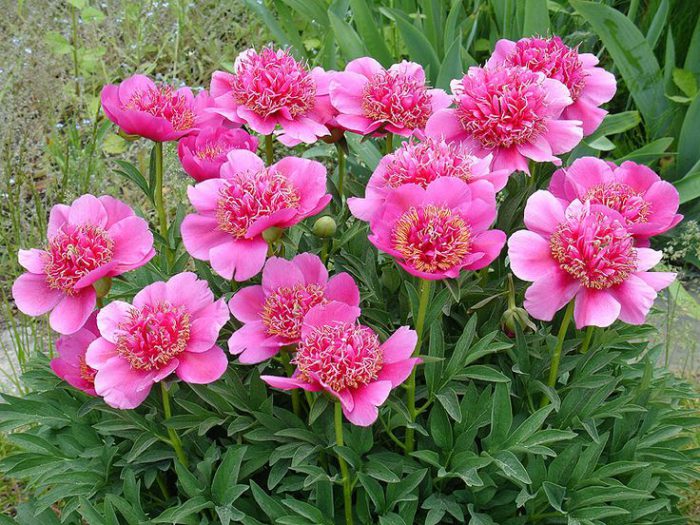
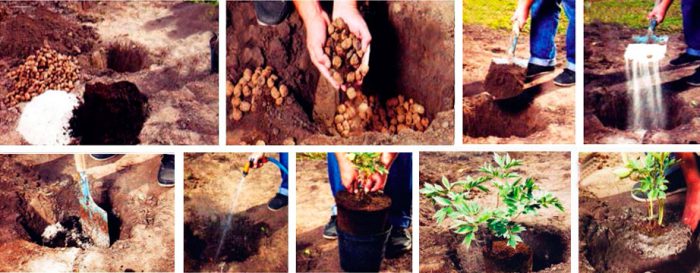
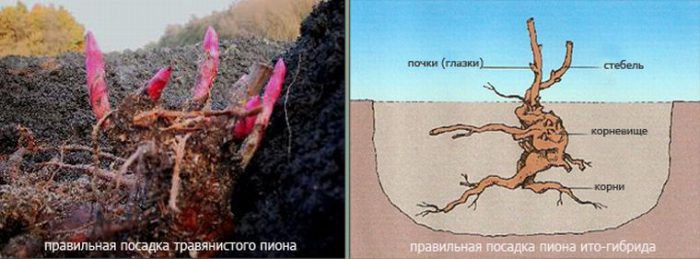




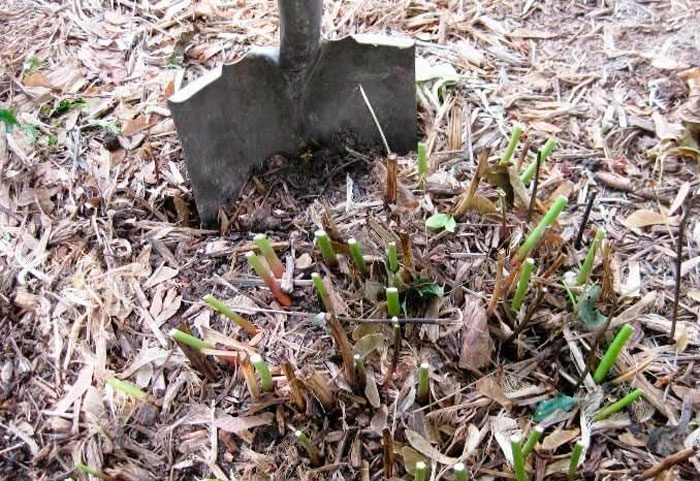



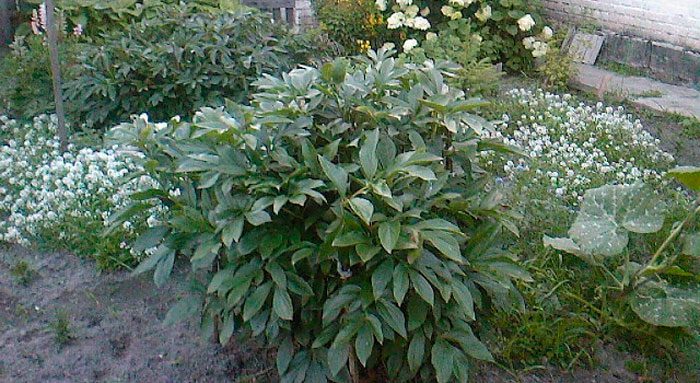




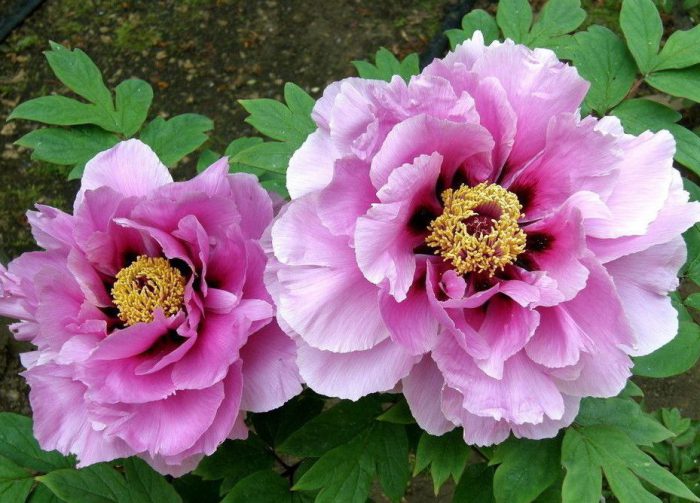
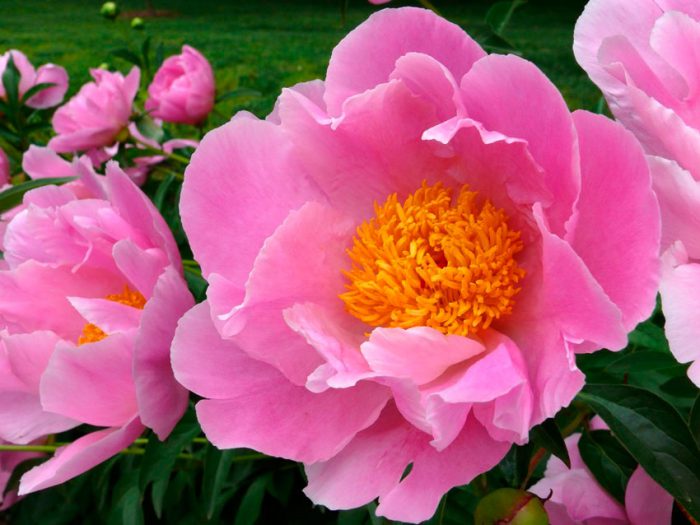
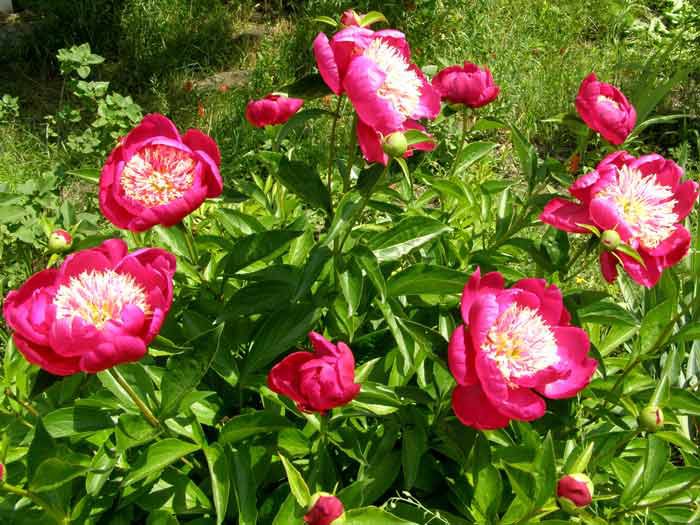












Do peonies have medicinal properties?
Peony rhizomes and seeds have useful properties. Peony contains tannins, flavonoids and other useful components.
Why did the peony pick up the buds and not bloom?